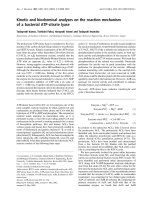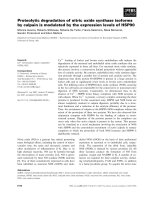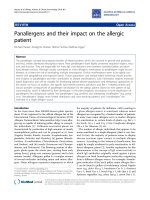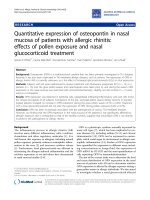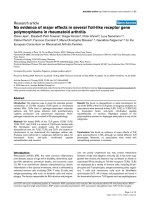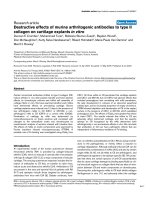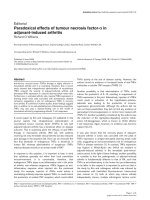Báo cáo y học: "Toxic effects of methoxychlor on the episodic prolactin secretory pattern: Possible mediated effects of nitric oxide production" pdf
Bạn đang xem bản rút gọn của tài liệu. Xem và tải ngay bản đầy đủ của tài liệu tại đây (458.46 KB, 9 trang )
BioMed Central
Page 1 of 9
(page number not for citation purposes)
Journal of Circadian Rhythms
Open Access
Research
Toxic effects of methoxychlor on the episodic prolactin secretory
pattern: Possible mediated effects of nitric oxide production
Anunciación Lafuente
1
, Teresa Cabaleiro
1
, Pilar Cano
2
and Ana I Esquifino*
2
Address:
1
Laboratorio de Toxicología, Facultad de Ciencias, Universidad de Vigo, Campus de Orense, Las Lagunas, 32004 Orense, Spain and
2
Departamento de Bioquímica y Biología Molecular III, Facultad de Medicina, Universidad Complutense, 28040 Madrid, Spain
Email: Anunciación Lafuente - ; Teresa Cabaleiro - ; Pilar Cano - ;
Ana I Esquifino* -
* Corresponding author
Abstract
Background: This work addresses the issue of whether methoxychlor (MTX) exposure may
modify the ultradian secretion of prolactin through changes in the synthesis of nitric oxide (NO)
induced by N
ω
-nitro-L-arginine methyl ester (L-NAME) in the hypothalamic-pituitary axis.
Associated changes in dopamine (DA) content in the anterior (AH), mediobasal (MBH) and
posterior hypothalamus (PH) and median eminence (ME) were evaluated.
Methods: Two groups of animals (MTX and MTX+L-NAME treated) received subcutaneous (sc)
injections of MTX at a dose of 25 mg/kg/day for one month. The other two groups of animals
(control and L-NAME treated) received sc vehicle injections (0.5 mL/day of sesame oil), during the
same period of time to be used as controls. Forty hours before the day of the experiment, animals
were anaesthetized with intrapritoneal injections of 2.5% tribromoethanol in saline and atrial
cannulas were implanted through the external jugular vein. Plasma was continuously extracted in
Hamilton syringes coupled to a peristaltic bomb in tubes containing phosphate-gelatine buffer (to
increase viscosity). The plasma was obtained by decantation and kept every 7 minutes for the
measurement of plasma prolactin levels through a specific radioimmnunoassay and DA
concentration by high-pressure liquid chromatography (HPLC).
Results: Prolactin release in animals from all experimental groups analyzed was episodic. Mean
plasma prolactin levels during the bleeding period, and the absolute pulse amplitude were increased
after MTX or N
ω
-nitro-L-arginine methyl ester (L-NAME) administration. However MTX and L-
NAME did not modify any other parameter studied with the exception of relative pulse amplitude
in MTX treated rats. L-NAME administration to rats treated with the pesticide reduced mean
plasma prolactin levels and the absolute amplitude of prolactin peaks. Peak duration, frequency and
relative amplitude of prolactin peaks were not changed in the group of rats treated with MTX plus
L-NAME as compared to either control or MTX treated rats. Whereas MTX decreased DA
content in the ME and increased it in the AH, its content did not change in the MBH or PH, as
compared to the values found in controls. Also, L-NAME administration decreased DA content in
the ME as compared to controls. However, L- NAME administration to MTX exposed rats,
markedly increased DA content in the ME as compared to either MTX treated or control rats. L-
NAME administration increased DA content in the AH as compared to the values found in non-
treated rats. However L-NAME administration to MTX exposed rats did not modify DA content
Published: 03 March 2006
Journal of Circadian Rhythms2006, 4:3 doi:10.1186/1740-3391-4-3
Received: 22 November 2005
Accepted: 03 March 2006
This article is available from: />© 2006Lafuente et al; licensee BioMed Central Ltd.
This is an Open Access article distributed under the terms of the Creative Commons Attribution License ( />),
which permits unrestricted use, distribution, and reproduction in any medium, provided the original work is properly cited.
Journal of Circadian Rhythms 2006, 4:3 />Page 2 of 9
(page number not for citation purposes)
as compared to either MTX treated or control rats. L-NAME administration did not modify DA
content at the MBH nor in saline treated nor in MTX treated rats. However, the values of DA in
the MBH in MTX plus L-NAME treated animals were statistically decreased as compared to L-
NAME treated rats. In the PH, L-NAME administration increased DA content as compared to the
values found in non-treated animals. L-NAME administration to MTX exposed rats also increased
DA content as compared to either MTX treated or control rats.
Conclusion: The results suggest the existence of an interaction between MTX and L-NAME in
the modulation of the ultradian prolactin secretion at the pituitary levels. The possibility of an
indirect effect mediated by changes in DA content at the ME requires further examination.
Introduction
Methoxychlor (MTX) is a pesticide and its chemical name
is 1,1,1-trichloro-2,2-bis(p-methoxy phenyl) ethane. It
was first synthesized in 1893, and its commercial produc-
tion in the United States began in 1946. This organochlo-
ride insecticide was found in 1.2 % of food samples in that
country, representing an intake of 0.1 to 0.8 µg MTX/day
for 16 to 19 year-old individuals [1].
It has been shown that MTX affects the reproductive func-
tion [2-10]. These effects were related to its estrogenic
properties [11-14] although controversial data were
reported [15]. The role of MTX on prolactin secretion is
also controversial: although prolactin pituitary content
and its in vitro release were elevated, the differences in cir-
culating values of the hormone (single determinations),
as compared to control animals, were not statistically sig-
nificant [4].
Nitric oxide (NO) has been implicated in the regulation of
the release of several hypothalamic molecules that are
involved in pituitary hormone secretion (e.g., biogenic
amines, amino acids, luteinizing hormone releasing-hor-
mone (LHRH), and vasoactive intestinal peptide) [16-23].
NO effects on prolactin secretion are to some extent con-
troversial. In fact, NO inhibits prolactin secretion from
hemipituitary cultures [24]. Blockade of NO synthesis by
the administration of N
ω
-nitro-L-arginine methyl ester (L-
NAME), inhibits the preovulatory peak of prolactin [25]
or attenuates the inhibitory effect of dopamine on prolac-
tin secretion [23,26]. On the other hand, NO stimulates
or inhibits prolactin secretion according with plasma
estrogen levels [27]. All those studies were performed in
the so-called basal conditions, although prolactin, like
other pituitary hormones, is secreted following an ultra-
dian episodic pattern [28,29].
Previous work from our laboratory has shown that basal
prolactin secretion [30], as well as its ultradian secretory
pattern, is changed by MTX exposure [31,32]. However,
we did not determine whether MTX effects on the ultra-
dian secretory pattern of prolactin secretion are mediated
by NO production. The objective of the present study was
to determine whether MTX exposure modifies the ultra-
dian secretion of prolactin through changes in NO. Asso-
ciated changes in dopamine (DA) content in the anterior
(AH), mediobasal (MBH) and posterior hypothalamus
(HP) and median eminence (ME) were evaluated.
Materials and methods
Reagents
Methoxychlor [MTX: 1,1,1-trichloro-2,2-bis(p-methoxy
phenyl) ethane], N
ω
-nitro-L-arginine methyl ester (L-
NAME), sodium chloride, and tribromoethanol were pur-
chased from Sigma-Aldrich (Saint Louis, MO, USA).
Heparin was purchased from LEO (Barcelona Spain).
Animals
Adult male Sprague-Dawley rats weighing 300–320 g at
the beginning of the experiment were used. They were
maintained with rat chow and water available ad libitum
in a room under controlled photoperiod (14 h light/10 h
darkness; lights on from 07.00 to 21.00 h) and tempera-
ture (22 ± 2°C).
Four groups of 8 animals were used. Two groups of the
animals (MTX and MTX+L-NAME groups) received subcu-
taneous (sc) injections of MTX at a dose of 25 mg/kg/day
for one month. MTX was dissolved in sesame oil at a con-
centration of 17.5 mg/mL. The other two groups of ani-
mals (control and L-NAME treated) received sc vehicle
injections (0.5 mL/day of sesame oil), during the same
period of time, to be used as controls.
Cannula implantation
Forty hours before the beginning of data collection, ani-
mals were anaesthetized with intraperitoneal injections of
2.5% tribromoethanol in saline (1 mL/100 g body
weight) and atrial cannulas were implanted through the
external jugular vein according to procedures used in pre-
vious studies [28,29]. This allows the animals to move
freely in their cages during the bleeding period.
Experimental design and blood sampling
On the day of data collection, conscious and freely mov-
ing rats from each group were continuously infused with
Journal of Circadian Rhythms 2006, 4:3 />Page 3 of 9
(page number not for citation purposes)
0.9 % saline (0.5 mL/h) for 4 h, beginning at 09.30 h. Ani-
mals of both control and MTX groups were intraperito-
neally (ip) injected with saline 1 h before the beginning of
the bleeding period. Rats of both L-NAME and MTX + L-
NAME groups were ip injected with L-NAME, a NO syn-
thase inhibitor, at a dose of 10 mg/kg in saline, 60 min-
utes before the beginning of the bleeding period. The
doses and timing for L-NAME administration were
selected according to previous data from the literature
[33,23,25]. One hour after the beginning of the intrave-
nous infusion of saline, and 15 min after the administra-
tion of 300 IU of heparin, rats were continuously bled
through a peristaltic pump at a flow rate of 50 µL every 7
min. Blood samples were collected in Hamilton microliter
syringes every 7 min for 3 h, from 10.30 h to 13.30 h. The
samples were collected into assay tubes and were kept on
ice that contained phosphate buffer (0.01 mol/L) with
0.1% gelatine to increase blood viscosity. Plasma was
obtained by decantation (26 samples from each rat) after
centrifugation (15 min at 3,000 rpm). Hematocrits
remained stable after this bleeding protocol.
The studies were conducted in accord with the principles
and procedures outlined in the NIH Guide for the Care
and Use of the Laboratory Animals.
Prolactin measurements
Prolactin levels, in all series from each rat, were deter-
mined by a specific double-antibody radioimmunoassay.
The reagents were kindly supplied by the National Hor-
mone and Pituitary Program (NHPP, Rockville, MD,
USA). Prolactin values were expressed in terms of NIADD
rat PRL-RP3 reference preparation. The sensitivity of the
assay was 5 pg/tube. To analyze the variability of the
assay, series of plasma of 10 replicates at 4 different con-
centrations of the prolactin standard curve were run. Coef-
ficients of variation were 8.6, 6.4, 5.7 or 4.7 % of 1.5, 6.25,
12, 25 or 25 ng/mL in the standard curve, respectively.
Samples were analyzed within the same assay to avoid
inter-assay variations. This assay is used routinely in our
laboratory [28,29,31,32].
Data Analysis
To identify and characterize prolactin pulses, a computer
program (Ultra-analysis), described by Van Cauter [34]
and reviewed by Richard [35], was used. In this program,
a pulse was defined as an increase exceeding a multiple of
the dose-adjusted coefficient of variance (CV), followed
by a significant decrease. The intraassay CV was calculated
from values of 4 different concentrations of prolactin (at
the level of 1.2, 6.25, 12 and 25 ng/mL) in its standard
curve. Thus, the CV and the mean hormone level were
determined for all hormone values that comprised the
ascending and descending phases of each feasible pulse.
The pulse was defined when this CV was triple that of the
intra-assay CV determined at comparable mean prolactin
levels. To test the specificity of pulse detection, a series of
26 samples from a pool of serum was analyzed using a
threshold of 3 CV for prolactin pulses. Extensive simula-
tion studies using computer-generated series indicated
that, for series that have large and frequent pulses, thresh-
old of 3 CV minimized both false positive and negative
errors [36].
The pulsatile pattern of prolactin secretion was character-
ised by determining the mean hormone levels, the abso-
lute and relative amplitudes of prolactin peaks, their
frequency and the pulse duration. The program also calcu-
lates the mean half-life of the hormone. The absolute
pulse amplitude was defined as the difference between the
hormone level at the maximum of the peak and the hor-
mone level at the preceding nadir. The relative pulse
amplitude was calculated as the quotient between abso-
lute pulse amplitude and preceding nadir value. Pulse fre-
quency was defined as the number of pulses observed
during the bleeding period. Pulse duration was the time
between the beginning of the ascending phase of the peak
and the end of the descending phase of the peak. The
mean hormone level was calculated by the mean of all
samples collected from each rat during the 3-hour period,
and the average for the experimental group from the indi-
vidual means. The half-life of the hormone is calculated
by the tangent of the descending phase of the peak.
Dopamine measurement
The hypothalamus and ME were quickly dissected out as
described previously [46]. The AH, MBH, PH and ME were
immediately dissected and homogenized in chilled (0–
1°C) 2 M acetic acid. After centrifugation (at 15,000 rpm
for 30 min, at 4°C), the supernatants were analyzed by
high performance liquid chromatography (HPLC), using
electrochemical detection (Coulochem, 5100A, ESA,
USA). A C-18 reverse phase column, eluted with a mobile
phase (pH = 4; 0.1 M sodium acetate, 0.1 M citric acid, 0.7
mM sodium octylsulphate and 0.57 mM EDTA containing
10% methanol, v/v), was employed. Flow rate was 1 mL/
min, at a pressure of 2200 psi. Fixed potentials against H
2
/
H
+
reference electrode were: conditioning electrode -0.4 V;
pre-oxidation electrode +0.10 V; working electrode +0.35
V. Dopamine concentration was calculated from the chro-
matographic peak areas by using external standards. The
linearity of the detector response for dopamine was tested
within the concentration ranges found in supernatants of
mediobasal hypothalamus [37].
Statistics
The results of the parameters measured in this study were
tested for variance homogeneity through the Snedecor test
(Snedecor, 1989). When the results did not have a homo-
geneous variance, they were compared through a Mann-
Journal of Circadian Rhythms 2006, 4:3 />Page 4 of 9
(page number not for citation purposes)
Whitney test. If the variance was homogeneous, the Stu-
dent's t-test or the analysis of variance (ANOVA) was
applied. The results were considered significant at P ≤
0.05. All values represent the mean ± S.E.M. To study the
MTX and L-NAME effects on the parameters that charac-
terize the episodic prolactin secretion and on dopamine
concentration, the comparison of values was done by one-
way analysis of variance (ANOVA). Finally, to test the
existence of an interaction between MTX and TRH, two
ways analysis of variance (ANOVA) was applied.
Results
Prolactin release in animals from the four experimental
groups analyzed was episodic, and a representative profile
from one animal of each experimental group is shown in
Figure 1. As is typical in male rats, the circadian rhythm of
prolactin shows a large pulse during the first hours of the
morning [31]. Therefore, sample values obtained during
the last 2 hr and 25 min of blood withdrawal were used to
profile the episodic pattern of prolactin release.
The mean plasma prolactin levels during the bleeding
period and the absolute pulse amplitude were increased
after MTX administration (Table 1; P ≤ 0.05 and P ≤ 0.001
vs. control group, respectively). In addition, the relative
pulse amplitude diminished in MTX-treated rats as com-
pared with the values found in the control group (Table 1;
P ≤ 0.01). However, the frequency and duration of prolac-
tin peaks and half-life of the hormone were not modified
by the treatment with the pesticide (Table 1). L-NAME
increased mean plasma levels of prolactin during the
bleeding period and the absolute amplitude of prolactin
peaks, as compared to controls (Table 1; P ≤ 0.01 and P ≤
0.05, respectively). However, L-NAME did not modify any
Individual episodic prolactin patterns during the whole bleeding period (B) and expanded detail of the pulsatile pattern of prol-actin during the last 2 hr and 25 min of bleeding (A)Figure 1
Individual episodic prolactin patterns during the whole bleeding period (B) and expanded detail of the pulsatile
pattern of prolactin during the last 2 hr and 25 min of bleeding (A). The arrows indicate the prolactin pulses during
the studied period. The left upper panel (I) shows the pulsatile pattern of prolactin in control rats treated with saline (vehicle
of L-NAME). The left lower panel (II) shows the pulsatile pattern of prolactin in rats treated with L-NAME (rats were ip admin-
istered N
ω
-nitro-L-arginine methyl ester at a dose of 10 mg/kg in saline, 60 minutes before the beginning of the bleeding
period). The right upper panel (III) shows the pulsatile pattern of prolactin in rats treated with MTX (animals were sc treated
with MTX al a dose of 25 mg/kg/day for 1 month). The right lower panel (IV) shows the pulsatile pattern of prolactin in rats
treated with MTX and L-NAME (the animals were sc treated with methoxychlor (25 mg/kg/day) for 1 month and L-NAME at a
dose of 10 mg/kg in saline, 60 minutes before beginning of the bleeding period).
Journal of Circadian Rhythms 2006, 4:3 />Page 5 of 9
(page number not for citation purposes)
other parameter studied to evaluate prolactin pulsatility
(Table 1). L-NAME administration to rats treated with the
pesticide reduced mean plasma prolactin levels and the
absolute amplitude of prolactin peaks (Table 1). Peak
duration, relative amplitude and frequency of prolactin
peaks were not change in the group of rats treated with
MTX plus L-NAME as compared to either control or MTX
treated rats. However, there was an increase in the mean
half-life of the hormone and a decrease in the absolute
amplitude of prolactin peaks as compared to the MTX
treated group (P ≤ 0.05). There was also a reduction in the
relative amplitude of the prolactin peaks as compared to
the values observed in control rats (Table 1; P ≤ 0.01).
Whereas MTX decreased DA content in the ME and
increased it in the the AH (Figure 2; P ≤ 0.01 vs. control
group), its content did not change in the MBH or PH as
compared to the values found in the control group (Figure
2).
L-NAME administration decreased DA content in the ME
(P ≤ 0.01) as compared to the values found in controls
(Figure 2). However, L-NAME administration to MTX
exposed rats greatly increased DA content as compared to
either MTX treated or control rats (P ≤ 0.001 for any com-
parison, Figure 2).
In the AH, L-NAME administration increased DA content
(P ≤ 0.05) as compared to the values found in non-treated
rats, but in MTX-exposed rats this enzymatic inhibitor did
not modify DA content as compared to either MTX treated
or control rats (Figure 2).
L-NAME administration did not modify DA content at the
MBH neither in saline treated nor in MTX treated rats.
However, the values of DA in MTX plus L-NAME treated
animals were statically decreased as compared to L-NAME
treated rats (P ≤ 0.01, Figure 2).
In the PH, L-NAME administration increased DA content
(P ≤ 0.05, Figure 2) as compared to the values found in
non-treated animals. In addition, in MTX exposed rats this
chemical also increased DA content as compared to either
MTX treated or control rats (P ≤ 0.05 and P ≤ 0.001 respec-
tively, Figure 2).
There was a statistically significant interaction between
MTX and L-NAME on the mean serum prolactin levels (F
= 4.46; P ≤ 0.05), absolute pulse amplitude (F = 14.58; P
≤ 0.01), half-life of the hormone (F = 7.85; P ≤ 0.01), and
DA concentration in the ME (F = 219.96; P ≤ 0.001).
Discussion
The results of this study suggest the existence of interac-
tion between L-NAME and MTX to regulate the ultradian
secretory pattern of prolactin. The associated changes in
the median eminence of DA content may explain the
changes in prolactin secretion mediated by MTX and L-
NAME.
The observed decline in serum prolactin levels between
10.30 and 11.30 in the control group, may be due to the
existence of circadian variations of the hormone previ-
ously described [38], and agrees with previous works from
our group [31,37,39].
Both MTX and L-NAME administration modified the
ultradian secretory pattern of prolactin showing increased
mean levels of the hormone during the bleeding period.
These results may be explained by the increased absolute
amplitude of prolactin peaks found in this study with
both MTX and L-NAME treatments. However, after MTX
Table 1: Mean serum prolactin levels, absolute and relative pulse amplitude, frequency and duration of the pulses, and mean half-life of
prolactin, in adult male rats.
Group rPRL-RP3
(ng/mL)
Absolute
Amplitude
(ng/mL)
Relative
amplitude (%)
Frequency
(Pulses/3 h)
Duration (min) Half-life (min)
Control 0.56 ± 0.11 0.43 ± 0.05 1.92 ± 0.23 5.17 ± 0.4 29.87 ± 3.92 20.19 ± 2.37
L-NAME 0.97 ± 0.10** 0.59 ± 0.03* 1.29 ± 0.39 4.90 ± 0.2 30.03 ± 2.39 19.06 ± 1.44
MTX 1.26 ± 0.26* 0.73 ± 0.08** 0.85 ± 0.17** 5.50 ± 0.5 27.01 ± 1.56 16.18 ± 0.81
MTX + L-NAME 1.02 ± 0.27 0.32 ± 0.11
#,&
0.77 ± 0.21** 5.25 ± 0.4 29.50 ± 2.10 25.30 ± 3.74
#
The relative pulse amplitude was calculated as the quotient between absolute pulse amplitude and preceding nadir value. Values are expressed as
mean ± S.E.M. The number of animals per group is 8. *P ≤ 0.05 ≤; **P ≤ 0.01 vs. Control;
#
P ≤ 0.05 vs. MTX group;
&
P ≤ 0.05 vs. NAME group.
Control group: the animals were ip injected with saline 60 minutes before beginning of the bleeding period, and vehicle 0.5 mL of sesame oil
(vehicle in which MTX was administered in MTX group) for 1 month.
L-NAME group: the animals were i.p. administered N
w
-nitro-L-arginine methyl ester (L-NAME) at a dose of 10 mg/kg in saline, 60 minutes before
beginning of the bleeding period.
MTX group: the animals were sc treated with methoxychlor (25 mg/kg/day) for 1 month.
MTX + L-NAME group: the animals were s.c. treated with methoxychlor (25 mg/kg/day) for 1 month and L-NAME at a dose of 10 mg/kg in
saline, 60 minutes before beginning of the bleeding period.
Journal of Circadian Rhythms 2006, 4:3 />Page 6 of 9
(page number not for citation purposes)
Dopamine (DA) content in the median eminence (ME), and in the anterior (AH), mediobasal (MBH) and posterior hypothala-mus (PH) in the adult control group, MTX-treated rats, L-NAME-treated animals and MTX plus L-NAME-treated ratsFigure 2
Dopamine (DA) content in the median eminence (ME), and in the anterior (AH), mediobasal (MBH) and pos-
terior hypothalamus (PH) in the adult control group, MTX-treated rats, L-NAME-treated animals and MTX
plus L-NAME-treated rats. The values are expressed as mean ± S.E.M. (n = 8 in each group). *P ≤ 0.05; **P ≤ 0.01 and ***P
≤ 0.001 vs. control group;
#
P ≤ 0.05 and
##
P ≤ 0.01 vs. MTX group;
&&
P ≤ 0.01 and
&&&
P ≤ 0.001 vs. L-NAME group.
Journal of Circadian Rhythms 2006, 4:3 />Page 7 of 9
(page number not for citation purposes)
treatment, our data do not agree with the results obtained
by Goldman [4], who did not find significant changes in
circulating levels of the hormone, although the prolactin
content in the pituitary increased. Differences may be due
to the length of MTX treatment (2 months in Goldman's
work vs. 1 month in our study), dosage approach (oral in
Goldman's work vs. subcutaneously in our study), age of
the animals at the beginning of pesticide exposure (21
days in Goldman's work vs. adult age in our study), or the
season in which the experiment was performed [40]. Also,
our present results differ from previous work reported in
the literature, where opposite [41] or no effects were
observed after L-NAME administration [19,20,33,42]
when analyzed at single point assay. The discrepancies
may be attributed to the differences in the experimental
approaches used in each study: route of administration of
L-NAME, dose of L-NAME used, or time of the day in
which the experiment was carried out. However, our data
obtained in L-NAME-treated animals confirms and
extends previous studies describing the inhibitory effect of
NO on prolactin secretion, both in vivo and in vitro
[43,19,24,16,44,43]. A direct effect of NO at the pituitary
level must be considered in light of previous studies [24],
although an indirect effect at the hypothalamic or the ME
level changing DA synthesis cannot be discarded.
The data obtained after MTX and L-NAME administration
indicate the existence of an interaction between the pesti-
cide and NO to modulate prolactin secretion. The increase
in AH DA content together with the decrease in this neu-
rotransmitter in the ME suggests that less DA is released
from the AH to the ME. These changes may explain the
observed modifications in prolactin secretion in this
study, as DA is the main inhibitory neuromodulator of
prolactin secretion [45,46]. The variations in the AH may
be also due to a direct effect of the hormone on the
hypothalamus to regulate its own secretion, as has been
previously suggested [47]. On the other hand, L-NAME
administration induced differential effects on hypotha-
lamic and ME dopamine contents. The interaction
between NO and dopamine has been previously demon-
strated by Yen and Pan [23]. The changes in DA content in
the median eminence, induced by L-NAME, may account
for the observed modifications in mean levels of prolac-
tin, considering that the amount of DA released to the
pituitary is directly related to its concentration in the ME
[48] and that this amine is the main inhibitory input for
prolactin secretion [49]. However, other neuroimmu-
nomodulators not monitoredin our study could also be
changed by modifications in NO production
[19,20,24,33,44].
When MTX and L-NAME were administered together, the
mean values of the hormone did not vary compared to the
control group. This may be explained by a direct effect on
the pituitary inducing the reduction of the absolute
amplitude of the prolactin peaks. Also, an indirect effect
mediated by the changes observed in ME DA content may
be considered.
The changes in DA content observed in the PH indicate
that MTX and L-NAME do not interact to change this
amine in this hypothalamic area. Interestingly only L-
NAME seems to be effective to modify DA in this hypoth-
alamic region, as MTX alone was not able to change the
content of this neurotransmitter. These modifications
may be associated with changes in autonomic nervous
system activity, an effect previously described in other
regions of the autonomic nervous system [50].
In summary the results obtained in this work indicate the
existence of interactions between MTX and L-NAME at the
pituitary level to regulate the ultradian secretory pattern of
prolactin. The possibility of an indirect effect mediated by
changes in DA content at the ME requires further exami-
nation.
Competing interests
The author(s) declare that they have no competing inter-
est.
Authors' contributions
AL and AIE designed the experiments. AL and PC carried
out the radioimmunoassay for prolactin and the analysis
of dopamine by HPLC. AL and TC performed the statisti-
cal analysis. TC took care of the experimental animals. AL
and AIE supervised the study and drafted the manuscript.
All authors read and approved the final manuscript.
Acknowledgements
This work was supported by grants from the University of Vigo (Uvigo,
TL1/1999).
References
1. Duggan RE, Corneliussen PE, Duggan MG, McMahon BM, Martin RJ:
Pesticide residue levels in foods in the United States from
July 1, 1969 to June 10, 1976. In Food and Drug Admin And Assoc of
Official Anal Chem Washington, D.C; 1983.
2. Tullner WW, Edgcomb JH: Cystic tubular nephropathy and
decrease in testicular weight in rats following oral methoxy-
chlor treatment. J Pharmacol Exp Ther 1962, 138:126-131.
3. Bal HS: Effect of methoxychlor on reproductive systems of
the rat. Proc Soc Exp Biol Med 1984, 176:187-196.
4. Goldman JM, Cooper RL, Rehnberg GL, Hein JF, McElroy WK, Gray
LE: Effects of low subchronic doses of methoxychlor on the
rat hypothalamic-pituitary reproductive axis. Toxicol Appl Phar-
macol 1986, 86:474-483.
5. You L, Casanova M, Bartolucci EJ, Fryczynski MW, Dorman DC,
Everitt JI, Gaido KW, Ross SM, Heck H: Combined effects of die-
tary phytoestrogen and synthetic endocrine-active com-
pound on reproductive development in Sprague-Dawley
rats: genistein and methoxychlor. Toxicol Sci 2002, 66:91-104.
6. Johnson L, Staub C, Silge RL, Harris MW, Chapin RE: The pesticide
Methoxychlor given orally during the perinatal/juvenile
period, reduced the spermatogenic potential of males as
adults by reducing their Sertoli cell number. Reprod Nutr
Develop 2002, 42:573-580.
Journal of Circadian Rhythms 2006, 4:3 />Page 8 of 9
(page number not for citation purposes)
7. Murono EP, Derk RC: The effects of the reported active metab-
olite of methoxychlor, 2,2-bis(p-hydroxyphenil)-1,1,1-
trichlorprthane, on testosterone formation by cultured Ley-
dig cells from young adult rats. Reprod Toxicol 2004, 19:135-146.
8. Goldman JM, Murr AS, Buckalew AR, Schmid JE, Abbott BD: Meth-
oxychlor-induced alterations in the histological expression of
angiogenic factors in pituitary and uterus. J Mol Histol 2004,
35:363-375.
9. Suzuki M, Lee HC, Chiba S, Yonezawa T, Nishihar M: Effects of
methoxychlor exposure during perinatal period on repro-
ductive function after maturation in rats. J Reprod Develop
2004, 50:455-461.
10. Symonds DA, Tomic D, Miller KP, Flaws JA: Methoxychlor induces
proliferation of the mouse ovarian surface epithelium. Toxicol
Sci 2005, 83:355-362.
11. Pfaff D, Keiner M: Atlas of estradiol-concentrating cells in the
central nervous system of the female rat. J Comp Neurol 1973,
151:121-158.
12. Maness SC, McDonnell D, Gaidom KW: Inhibition of androgen
receptor-dependent transcriptional activity by DDT isomers
and methoxychlor in HepG2 human hepatoma cells. Toxicol
App Pharmacol 1998, 151:135-142.
13. Gaido KW, Maness SC, McDonnell DP, Dehal SS, Kupper D, Safe S:
Interaction of methoxychlor and related compounds with
estrogen receptor alpha and beta, and androgen receptor:
structure-activity studies. Mol Pharmacol 2000, 58:852-858.
14. Laws SC, Carey SA, Ferrell JM, Bodman GJ, Cooper RL: Estrogenic
activity of octylphenol, nonylphenol, bisphenol A and meth-
oxychlor in rats. Toxicol Sci 2000, 54:154-167.
15. Gray LE, Ostby J, Cooper RL, Kelce WR: The estrogenic and
antiandrogenic pesticide methoxychlor alters the reproduc-
tive tract and behaviour without affecting pituitary size or
LH and prolactin secretion in male rats. Toxicol Ind Health 1999,
15:37-47.
16. McCann SM, Kimura M, Karanth S, Yu WH, Rettori V: Nitric oxide
controls the hypothalamic-pituitary response to cytokines.
Neuroimmunomodulation 1997, 4:98-106.
17. Seilicovich , Lasaga M, Befumo M, Duvilanski BH, Díaz MC, Rettori V,
McCann SM: Nitric oxide inhibits the release of norepine-
phrine and dopamine from the medial basal hypothalamus of
the rat. Proc Nat Acad Sci USA 1995, 92:11299-11302.
18. McCann SM: The nitric oxide hypothesis of brain aging. Exp
Gerontol 1997, 32:431-440.
19. Aguilar E, Tena-Sempere M, Aguilar R, González D, Pinilla L: Interac-
tions between N-methyl Daspartate, nitric oxide and serot-
onin in the control of prolactin secretion in prepubertal male
rats. Eur J Endocrinol 1997, 13:99-106.
20. Chiodera P, Volpi R, Coiro V: Involvement of nitric oxide in
vasoactive intestinal peptide-stimulated prolactin secretion
in normal men. Metabolism 1998, 47:897-899.
21. Gouveia EM, Franci CR: Involvement of serotonin 5HT1 and 5-
HT2 receptors and nitric oxide synthase in the medial pre-
potic area on gonadotropin secretion. Brain Res Bull 2004,
63:243-251.
22. Kiss JP, Zsilla G, Vizi ES: Inhibitory effect of nitric oxide on
dopamine transporters: interneuronal communication with-
out receptors. Neurochem Int 2004, 45:485-489.
23. Yen SH, Pan JT: Nitric oxide plays an important role in the
diurnal change of tuberoinfundibular dopaminergic neuronal
activity and prolactin secretion in ovariectomized, estrogen/
porgestterone-treated rats. Endocrinology 1999, 140:286-291.
24. Duvilanski BH, Zambruno C, Seilicovich A, Pisera D, Lasaga M, Diaz
MC, Belova N, Rettori V, McCann SM: Role of nitric oxide in con-
trol of prolactin release by the adenohypophysis. Proc Nat
Acad Sci US 1995, 92:170-174.
25. Pinilla L, González LC, Tena-Sempere M, Bellido C, Aguilar E: Effects
of systemic blockade of nitric oxide synthases on pulsatile
LH, prolactin, and GH secretion in adult male rats. Hor Res
2001, 55:229-235.
26. González D, Aguilar E: In vitro, nitric oxide (NO) stimulates LH
secretion and partially prevents the inhibitory effect of
dopamine on PRL release. J Endocrinol Invest 1999, 22:772-780.
27. Moreno AS, Carey SA, Ferrel JM, Bodman GJ, Cooper RL: Estro-
genic activity of octylphenol, monylphenol, bisphenol A and
methoxychlor in rats. Toxicol Sci 2000, 54:154-167.
28. Lafuente A, Marcó J, Esquifino AI: Pulsatile prolactin secretory
patterns throughout the oestrous cycle in the rat. J Endocrinol
1993, 137:43-47.
29. Lafuente A, Marcó J, Esquifino AI: Physiological roles of thyro-
trophin-releasing hormone and vasoactive intestinal peptide
on the pulsatile secretory pattern of prolactin in pituitary-
grafted female rats. J Endocrinol 1994, 142:181-186.
30. Tarasco M: Posible papel mediador del óxido nítrico en las
alteraciones inducidas por el metoxicloro en el eje
hipotálamo-hipofisario en rata macho. In Doctoral Thesis Uni-
versidad de Santiago de Compostela, Santiago de Compostela, Spain;
1994.
31. Lafuente A, Márquez N, Pousada Y, Pazo D, Esquifino AI: Possible
both estrogenic and/or antiandrogenic effects of methoxy-
chlor on prolactin release in male rats. Arch Toxicol 2000,
74:270-275.
32. Lafuente A, González-Carracedo A, Romero A, Esquifino AI: Meth-
oxychlor modifies the ultradian secretory pattern of prolac-
tin and affects its TRH response. Med Sci Monitor 2003,
9:137-142.
33. Matton A, Boolengier F, Finne E, Vanhaelst L: Effect of N-omega-
nitro-L-arginine methyl ester, a nitric oxide synthesis inhibi-
tor, on stress- and morphine-induced prolactin release in
male rats. Br J Pharmacol 1997, 120:268-272.
34. Van Cauter E: Diurnal and ultradian rhythms in human endo-
crine function: A minireview. Horm Res 1990, 34:45-53.
35. Richard JL, Bringer J, Daurós JP, Parer-Richard C, Jaffiol C, Mirouze J:
Methodes d'analyse de la pulsatilité hormonale. Ann Endocrinol
1990, 51:181-193.
36. Van Cauter E: Estimating false-positive and false-negative
errors in analyses of hormonal pulsatility. Am J Physiol 1988,
245:E786-E794.
37. Lafuente A, González-Carracedo A, Romero A, Cano P, Esquifino AI:
Effect of N
w
-nitro-L-arginine methhyl ester, a nitric oxide
synthesis inhibitor, on the pulsatile secretory pattern of pro-
lactin in conscious adult male rats. Life Sci 2004, 74:1681-1690.
38. Selgas L, Arce A, Esquifino AI, Cardinali DP: Twenty-four-hour
rhythms of serum ACTH, prolactin, growth hormone, and
thyroid-stimulating hormone, and of median-eminence
norepinephrine, dopamine, and serotonin, in rats injected
with Freund's adjuvant. Chronobiol Int 1997, 14:253-265.
39. Lafuente A, González-Carracedo A, Romero A, Cabaleiro T, Esqui-
fino AI: Toxic effects of cadmium on the regulatory mecha-
nism of dopamine and serotonin on prolactin secretion in
adult male rats. Toxicol Lett 2005, 155:87-96.
40. Esquifino AI, Pazo D, Cutrera RA, Cardinali DP: Seasonally-
dependent effect of ectopic pituitary grafts on 24-hour
rhythms in serum prolactin and gonadotropins in rat. Chrono-
biology International 1999, 16:451-460.
41. Bonavera JJ, Sahu A, Kalra PS, Kalra SP: Evidence in support of
nitric oxide (NO) involvement in the cyclic release of prolac-
tin and LH surges. Brain Res 1994, 660:175-179.
42. Gonzalez MC, Linares JD, Santos M, Llorente E: Effects of nitric
oxide donors sodium nitroprusside and 3-morpholinosyd-
norimine on prolactin secretion in conscious rats. Neurosci
Lett 1996, 203:167-170.
43. McCann SM, Karanth S, Kimura M, Yu WH, Rettori V: The role of
nitric oxide (NO) in control of hypothalamic-pituitary func-
tion. Rev Bras Biol 1996, 56:105-112.
44. Theas S, Pisera D, Duvilanski B, De Lauventiis A, Pampillo M, Lasage
M, Seilicovich A: Estrogens modulate the inhibitory effect of
tumor necrosis factor alpha on anterior pituitary cell prolif-
eration and prolactin release. Endocrine 2001, 12:249-255.
45. Tresguerres JA, Esquifino AI: Dissociation in the regulation of
luteinizing hormone and follicle-stimulating hormone in a
hyperprolactinaemic rat model: interrelationships between
gonadotrophin and prolactin control. J Endocrinol 1981,
90:41-51.
46. Esquifino AI, Moreno ML, Arce A, Agrasal C, Pérez-Díaz J, Villanua
MA: Effects of cyclosporine at the hypothalamic-pituitary
axis in pituitary-grafted young female rats. J Endocrinol 1981,
144:156-164.
47. Esquifino AI, Ramos JA, Tresguerres JAF: Possible role of
dopamine in changes in LH and prolactin concentrations
after experimetally induced hyperprolactinaemia in rats. J
Endocrinol 1984, 100:141-148.
Publish with BioMed Central and every
scientist can read your work free of charge
"BioMed Central will be the most significant development for
disseminating the results of biomedical research in our lifetime."
Sir Paul Nurse, Cancer Research UK
Your research papers will be:
available free of charge to the entire biomedical community
peer reviewed and published immediately upon acceptance
cited in PubMed and archived on PubMed Central
yours — you keep the copyright
Submit your manuscript here:
/>BioMedcentral
Journal of Circadian Rhythms 2006, 4:3 />Page 9 of 9
(page number not for citation purposes)
48. Esquifino AI, Cano P, Jimenez V, Reyes Toso CF, Cardinali DP:
Changes of prolactin regulatory mechanisms in aging: 24-
hour rhythms of serum prolactin and median eminence and
adenohypophysial concentration of dopamine, serotonin,
gamma-aminobutyric acid, taurine and somatostatin in
young and aged rats. Exp Gerontol 2004, 39:45-52.
49. Balsa JA, Sanchez-Franco F, Pazos F, Lara JI, Lorenzo MJ, Maldonado
G, Cacicedo L: Direct action of serotonin on prolactin, growth
hormone, corticotrophin and luteinizing hormone release in
cocultures of anterior and posterior pituitary lobes: auto-
crine and/or paracrine action of vasoactive intestinal pep-
tide. Neuroendocrinology 1998, 68:326-333.
50. Sartori C, Lepori M, Scherrer U: Interaction between nitric
oxide and the cholinergic and sympathetic nervous system in
cardiovascular control in humans. Pharmacol Ther 2005,
106:209-220.

